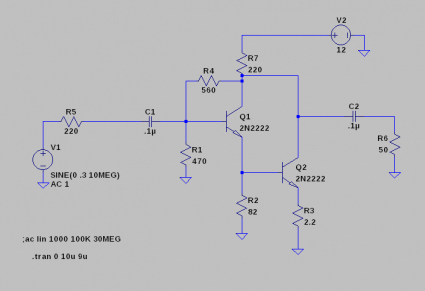I recall burning three or four weeks of a sabbatical getting Saccade.com on the air with Wordpress. So much tweaking…
Playing with a buffer amplifier for a DDS…
I tinkered together a circuit for a buffer amplifier that I thought would be good to use with the AD9850 DDS board I have. In particular, for the purpose of this exercise, I was trying to preserve the nice sine-wave nature of the DDS input, and present it at the output into a 50 ohm load. I dug around and ended up creating this circuit in LTSpice.
(I didn’t do the design, it was from my notes, but I failed to crib where it originally came from.)
I know it is is ridiculous to look at this from the standpoint of efficiency, but this feedback amp is astonishingly inefficient. Overall power draw averages at 470mw, with only 2.6mw of power actually delivered into the 50 ohm load. That seems pretty ridiculous in terms of efficiency.
Surely there must be a better way (power wise) to preserve the original waveform over a large range of possible output frequencies, yes? Or maybe not. I feel like understanding this is one of those teaching moments for me.
Comments
Comment from Elwood Downey
Time 5/4/2015 at 7:54 am
The SGA3486 is a nice MMIC amp. See data sheet at http://www.rfmd.com/store/downloads/dl/file/id/27974/sga3486z_data_sheet.pdf and example application in the FoxDelta antenna analyzed at http://foxdelta.com/products/infinity/AAZ-0914A/aaz0914a-schematic.jpg.
Comment from Kevin
Time 5/22/2015 at 9:21 am
If you do use this transistor amp, don’t forget you’re gonna have to choke the power supply leads. Like above, I’d use an op amp. The THD on your 2 transistor amp is gonna be terrible. As far as power savings a broad band op amp is gonna standby with a quarter watt or more.
http://www.analog.com/media/en/technical-documentation/data-sheets/AD844.pdf
This one looked good. Maybe it’s big brother? But this one is $2.

Comment from Chris Johnson
Time 5/1/2015 at 12:23 pm
A class AB amplifier would be more efficient. Have you looked at using a video buffer amplifier for this? There are quite a few available that can drive 50-100mA into a 50ohm load, and have more than enough bandwidth for the AD9850. See http://www.newark.com/buffers-video